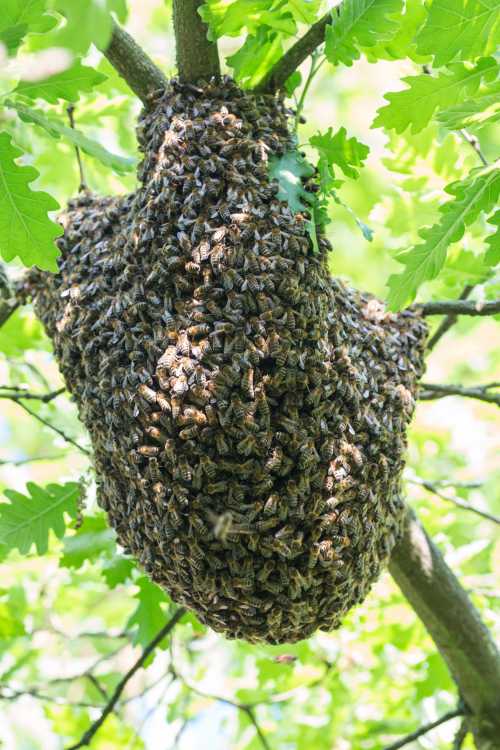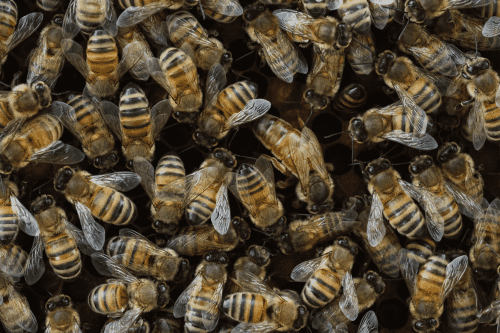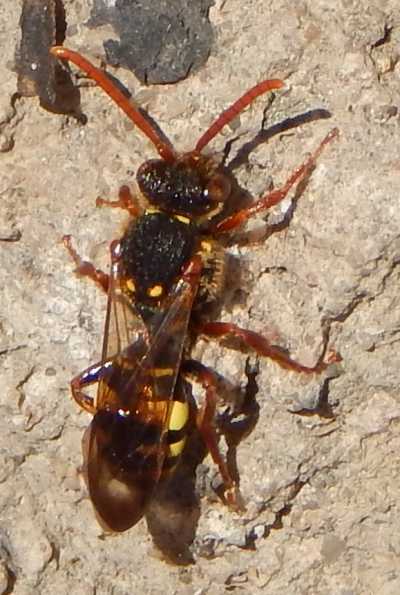How Big Is The Brain Of A Bee?
Bees may be small, but they are known for being smart. Bees have been trained to navigate mazes, sniff out bombs and more.
This may lead use to ask, how big is a bee's brain?
We measure tiny bee brains by weight, and the answer is, not surprisingly, it depends on the size and species of bee.
However, from research, we know that:
- the brain of the honey bee (Apis mellifera) weighs about 2mg;
- the brain of bumble bees (Bombus) weigh about 2 - 3mg; and
- the brains of large carpenter bees (Xylocopa) are bigger still, weighing about 5 - 7.5mg.
At the other end of the scale are some of the base-banded furrow bees (Lassioglossum) and the yellow-face bees (Hylaeus), which have brains that weigh less than half a milligram.
Below, this topic is explored in greater detail, looking at the recorded brain sizes of 93 species of bee.
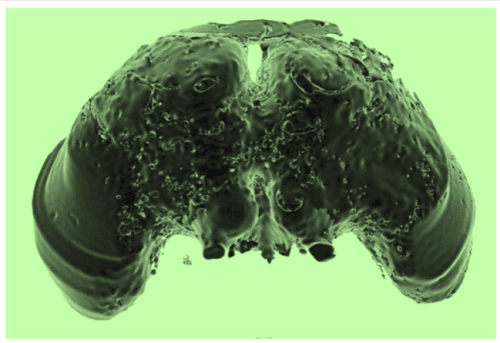 The brain of a honey bee, Apis mellifera
The brain of a honey bee, Apis melliferaImage after Smith, D., Bernhardt, G., Raine, N. et al. Exploring miniature insect brains using micro-CT scanning techniques. Sci Rep 6, 21768 (2016). https://doi.org/10.1038/srep21768
How Big Is A Bee Brain?
Which Bee Has The Largest / Smallest Brain?
Unless we measure the brain of every single bee in the world, we cannot be sure which bee has the largest brain, although we could hazard a reasonable guess that the biggest bee brain probably belongs to the world's largest known bee species, Megachile pluto, Wallace's giant bee.
However, I'm not aware of any research data providing the weight of its brain, and I wouldn't want to hear of any new research in which this species was dissected just to find out - they are rare!
Likewise, the bees with the tiniest brains are quite likely to be the world's smallest bees, currently believed to be Perdita minima and Quasihesma clypearis.
Are bees with larger brains more clever than bees with smaller brains?
This may or may not be true. For example one study showed that large bumble bee workers are more efficient foragers and are better learners than their smaller sisters.
However, we cannot know for sure whether a bumble bee species with a larger brain than a honey bee, is therefore always smarter (according to the limits of any experiment humans could devise to answer the question). In fact, there is plenty of research assessing the ability of honey bees in particular to learn concepts, recognize, remember, among other skills - see Are Bees Smart?
In comparison, there is little research testing the intelligence of other bees.
In any event, with so many species in the world, we cannot possibly make generalizations and comparisons for all bees, based only on what we know about one species.
What we do know about the size of bee brains...
However, we know the sizes of brains of 93 different bee species, thanks to a piece of research in which this data was collected.
From that particular study, the smallest was the brain of Lasioglossum sexstrigatum, the Fringed furrow bee, with a brain weighing 0.23mg, and the largest was that of the Carpenter bee, Xylocopa valga with a brain weighing 7.43mg.
The full tables of data for the 93 bees are provided further down this page, however, it's probably worth summarizing some of the information into key points.
Largest bee brains
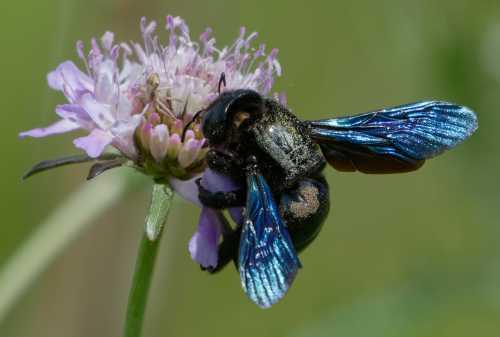 Violet carpenter bee Xylocopa violacea - a species with one of the largest brains in the study.
Violet carpenter bee Xylocopa violacea - a species with one of the largest brains in the study.Of the 93 species studied, the top 5 bees with the largest brains were mostly the large carpenter bees, Xylocopa, along with one other species, the Florentine wool carder:
| Species | Common Name | Brain Size (mg) |
|---|---|---|
| Xylocopa valga | Carpenter Bee | 7.43 |
| Xylocopa violacea | Violet Carpenter Bee | 5.876 |
| Xylocopa virginica | Eastern Carpenter Bee | 5.438 |
| Xylocopa cantabrita | Cantabrian Carpenter Bee | 4.968 |
| Anthidium florentinum | Florentine Wool Carder Bee | 4.46 |
However, when we consider the size of the brain in proportion to the body, the White-banded digger bee enters the top 5.
| Species | Common Name | Body Size ITS (mm) | Brain Size (mg) | Brain mg /mm |
|---|---|---|---|---|
| Xylocopa valga | Carpenter Bee | 7.024 | 7.43 | 1.058 |
| Anthidium florentinum | Florentine Wool Carder Bee | 4.254 | 4.46 | 1.048 |
| Amegilla quadrifasciata | White-banded digger bee | 3.849 | 3.926 | 1.020 |
| Xylocopa virginica | Eastern Carpenter Bee | 5.518 | 5.438 | 0.986 |
| Xylocopa violacea | Violet Carpenter Bee | 6.095 | 5.876 | 0.964 |
Bee brain size grouped by genus (type)
I grouped some (but not all) of the species by commonly-known type (genus).
For example, I grouped all of the bumble bees in the study together, and separately, the leafcutters etc, and looked at the range in sizes, just for comparison. (There is some slight rounding of numbers in the table).
Remember the study provided data for 93 species, and whilst this is a lot of bees, there are about 25,000 known species in the world. Any study can only reasonably provide us with a small snapshot.
| Bee type | Genus | Brain size range (mg) |
|---|---|---|
| Large carpenter bees | Xylocopa | 4.97 - 7.43 |
| Bumble bees | Bombus | 2.19 - 3.15 |
| Leafcutter bees | Megachile | 1.45 - 2.96 |
| Wool carders | Anthidium | 1.83 - 4.46 |
| Honey bee | Apis mellifera | 1.93 |
| Plaster bees | Colletes | 1.84 -1.96 |
| Mason bees | Osmia | 0.58 - 1.94 |
| Mining bees | Andrena | 0.25 - 1.97 |
| End-banded furrow bees | Lassioglossum | 0.23 - 0.82 |
| Yellow-face bees | Hyleaus | 0.26 - 0.29 |
The ranked brain size of 93 species of bee
Below are the sizes of brains of all 93 bee species included in the study.
| Species | Subfamily | Brain Size (mg) |
|---|---|---|
| Xylocopa valga | Xylocopinae | 7.43 |
| Xylocopa violacea | Xylocopinae | 5.876 |
| Xylocopa virginica | Xylocopinae | 5.438 |
| Xylocopa cantabrita | Xylocopinae | 4.968 |
| Anthidium florentinum | Megachilinae | 4.46 |
| Amegilla quadrifasciata | Apinae | 3.926 |
| Anthophora plumipes | Apinae | 3.676 |
| Bombus vagans | Apinae | 3.147 |
| Bombus fervidus | Apinae | 3.066 |
| Megachile pugnata | Megachilinae | 3 |
| Megachile ligniseca | Megachilinae | 2.963 |
| Bombus terrestris | Apinae | 2.823 |
| Bombus impatiens | Apinae | 2.821 |
| Bombus pascuorum | Apinae | 2.71 |
| Megachile latimanus | Megachilinae | 2.575 |
| Rhodanthidium sticticum | Megachilinae | 2.55 |
| Megachile mendica | Megachilinae | 2.452 |
| Bombus hortorum | Apinae | 2.334 |
| Bombus jonellus | Apinae | 2.301 |
| Bombus hypnorum | Apinae | 2.29 |
| Anthophora quadrimaculata | Apinae | 2.223 |
| Bombus pratorum | Apinae | 2.189 |
| Bombus muscorum | Apinae | 2.182 |
| Anthidium manicatum | Megachilinae | 2.053 |
| Andrena nitida | Andreninae | 1.974 |
| Colletes compactus | Colletinae | 1.962 |
| Osmia cornuta | Megachilinae | 1.94 |
| Apis mellifera | Apinae | 1.927 |
| Colletes simulans | Colletinae | 1.839 |
| Megachile mucida | Megachilinae | 1.839 |
| Anthidium oblongatum | Megachilinae | 1.83 |
| Andrena carantonica | Andreninae | 1.811 |
| Andrena nigroaenea | Andreninae | 1.713 |
| Melissodes desponsus | Apinae | 1.655 |
| Andrena tibialis | Andreninae | 1.648 |
| Megachile relativa | Megachilinae | 1.635 |
| Andrena cineraria | Andreninae | 1.633 |
| Panurgus banksianus | Panurginae | 1.63 |
| Melissodes bimaculata | Apinae | 1.614 |
| Megachile rotundata | Megachilinae | 1.6 |
| Andrena gravida | Andreninae | 1.594 |
| Andrena fulva | Andreninae | 1.591 |
| Eucera elongatula | Apinae | 1.59 |
| Andrena carlini | Andreninae | 1.558 |
| Andrena morio | Andreninae | 1.55 |
| Dasypoda hirtipes | Dasypodainae | 1.47 |
| Megachile centuncularis | Megachilinae | 1.449 |
| Andrena flavipes | Andreninae | 1.359 |
| Andrena dunningi | Andreninae | 1.348 |
| Nomada succincta | Nomadinae | 1.34 |
| Osmia bicornis | Megachilinae | 1.241 |
| Andrena varians | Andreninae | 1.17 |
| Andrena haemorrhoa | Andreninae | 1.166 |
| Osmia leaiana | Megachilinae | 1.103 |
| Hoplitis papaveris | Megachilinae | 1.1 |
| Systropha planidens | Rophitinae | 0.92 |
| Agapostemon sericeus | Halictinae | 0.855 |
| Osmia caerulescens | Megachilinae | 0.855 |
| Andrena barbilabris | Andreninae | 0.846 |
| Halictus rubicundus | Halictinae | 0.839 |
| Andrena chrysosceles | Andreninae | 0.831 |
| Lasioglossum sexnotatum | Halictinae | 0.818 |
| Andrena nigriceps | Andreninae | 0.814 |
| Andrena nubecula | Andreninae | 0.767 |
| Andrena ovatula | Andreninae | 0.746 |
| Lasioglossum coriaceum | Halictinae | 0.742 |
| Augochlora pura | Halictinae | 0.734 |
| Andrena simplex | Andreninae | 0.733 |
| Andrena dorsata | Andreninae | 0.718 |
| Andrena bicolor | Andreninae | 0.703 |
| Andrena fucata | Andreninae | 0.701 |
| Lasioglossum zonulum | Halictinae | 0.657 |
| Lasioglossum calceatum | Halictinae | 0.656 |
| Flavipanurgus venustus | Panurginae | 0.62 |
| Halictus ligatus | Halictinae | 0.617 |
| Andrena miserabilis | Andreninae | 0.6 |
| Osmia submicans | Megachilinae | 0.584 |
| Andrena labiata | Andreninae | 0.58 |
| Ceratina calcarata | Xylocopinae | 0.502 |
| Panurgus calcaratus | Panurginae | 0.487 |
| Lasioglossum leucozonium | Halictinae | 0.48 |
| Lasioglossum cressonii | Halictinae | 0.466 |
| Heriades rubicola | Megachilinae | 0.42 |
| Halictus confusus | Halictinae | 0.418 |
| Stelis breviuscula | Megachilinae | 0.382 |
| Andrena subopaca | Andreninae | 0.343 |
| Lasioglossum fulvicorne | Halictinae | 0.3 |
| Lasioglossum punctatissimum | Halictinae | 0.298 |
| Lasioglossum imitatum | Halictinae | 0.297 |
| Hylaeus modestus | Hylaeinae | 0.287 |
| Hylaeus mesillae | Hylaeinae | 0.26 |
| Andrena semilaevis | Andreninae | 0.254 |
| Lasioglossum sexstrigatum | Halictinae | 0.231 |
The ranked brains size of 93 species of bee, in proportion to body size by ITS
The rankings of bee brains change a little, when we consider the size of the brain in proportion to the body.
| Species | Subfamily | Body Size ITS (mm) | Brain Size (mg) | Brain mg /mm |
|---|---|---|---|---|
| Xylocopa valga | Xylocopinae | 7.024 | 7.43 | 1.058 |
| Anthidium florentinum | Megachilinae | 4.254 | 4.46 | 1.048 |
| Amegilla quadrifasciata | Apinae | 3.849 | 3.926 | 1.020 |
| Xylocopa virginica | Xylocopinae | 5.518 | 5.438 | 0.986 |
| Xylocopa violacea | Xylocopinae | 6.095 | 5.876 | 0.964 |
| Xylocopa cantabrita | Xylocopinae | 5.378 | 4.968 | 0.924 |
| Anthophora plumipes | Apinae | 4.08 | 3.676 | 0.901 |
| Rhodanthidium sticticum | Megachilinae | 3.272 | 2.55 | 0.779 |
| Megachile ligniseca | Megachilinae | 3.9 | 2.963 | 0.760 |
| Megachile pugnata | Megachilinae | 4.08 | 3 | 0.735 |
| Bombus fervidus | Apinae | 4.2 | 3.066 | 0.730 |
| Megachile latimanus | Megachilinae | 3.571 | 2.575 | 0.721 |
| Anthidium manicatum | Megachilinae | 2.874 | 2.053 | 0.714 |
| Andrena nitida | Andreninae | 2.808 | 1.974 | 0.703 |
| Colletes compactus | Colletinae | 2.814 | 1.962 | 0.697 |
| Colletes simulans | Colletinae | 2.66 | 1.839 | 0.691 |
| Panurgus banksianus | Panurginae | 2.379 | 1.63 | 0.685 |
| Bombus hypnorum | Apinae | 3.37 | 2.29 | 0.680 |
| Bombus pascuorum | Apinae | 3.995 | 2.71 | 0.678 |
| Bombus impatiens | Apinae | 4.184 | 2.821 | 0.674 |
| Bombus vagans | Apinae | 4.696 | 3.147 | 0.670 |
| Andrena carantonica | Andreninae | 2.775 | 1.811 | 0.653 |
| Nomada succincta | Nomadinae | 2.057 | 1.34 | 0.651 |
| Bombus terrestris | Apinae | 4.351 | 2.823 | 0.649 |
| Bombus hortorum | Apinae | 3.65 | 2.334 | 0.639 |
| Apis mellifera | Apinae | 3.018 | 1.927 | 0.639 |
| Melissodes desponsus | Apinae | 2.604 | 1.655 | 0.636 |
| Bombus pratorum | Apinae | 3.497 | 2.189 | 0.626 |
| Megachile mendica | Megachilinae | 4.01 | 2.452 | 0.611 |
| Andrena gravida | Andreninae | 2.635 | 1.594 | 0.605 |
| Melissodes bimaculata | Apinae | 2.672 | 1.614 | 0.604 |
| Andrena cineraria | Andreninae | 2.724 | 1.633 | 0.599 |
| Anthidium oblongatum | Megachilinae | 3.115 | 1.83 | 0.587 |
| Megachile mucida | Megachilinae | 3.164 | 1.839 | 0.581 |
| Andrena fulva | Andreninae | 2.76 | 1.591 | 0.576 |
| Anthophora quadrimaculata | Apinae | 3.86 | 2.223 | 0.576 |
| Andrena carlini | Andreninae | 2.712 | 1.558 | 0.574 |
| Bombus jonellus | Apinae | 4.018 | 2.301 | 0.573 |
| Bombus muscorum | Apinae | 3.812 | 2.182 | 0.572 |
| Megachile rotundata | Megachilinae | 2.86 | 1.6 | 0.559 |
| Eucera elongatula | Apinae | 2.846 | 1.59 | 0.559 |
| Megachile relativa | Megachilinae | 2.963 | 1.635 | 0.552 |
| Osmia cornuta | Megachilinae | 3.631 | 1.94 | 0.534 |
| Andrena morio | Andreninae | 3.04 | 1.55 | 0.510 |
| Andrena tibialis | Andreninae | 3.27 | 1.648 | 0.504 |
| Dasypoda hirtipes | Dasypodainae | 2.957 | 1.47 | 0.497 |
| Hoplitis papaveris | Megachilinae | 2.213 | 1.1 | 0.497 |
| Andrena dunningi | Andreninae | 2.784 | 1.348 | 0.484 |
| Andrena nigroaenea | Andreninae | 3.573 | 1.713 | 0.479 |
| Andrena haemorrhoa | Andreninae | 2.436 | 1.166 | 0.479 |
| Andrena varians | Andreninae | 2.52 | 1.17 | 0.464 |
| Andrena flavipes | Andreninae | 2.928 | 1.359 | 0.464 |
| Andrena nubecula | Andreninae | 1.709 | 0.767 | 0.449 |
| Andrena chrysosceles | Andreninae | 1.853 | 0.831 | 0.448 |
| Megachile centuncularis | Megachilinae | 3.402 | 1.449 | 0.426 |
| Osmia leaiana | Megachilinae | 2.766 | 1.103 | 0.399 |
| Osmia bicornis | Megachilinae | 3.172 | 1.241 | 0.391 |
| Lasioglossum coriaceum | Halictinae | 1.905 | 0.742 | 0.390 |
| Systropha planidens | Rophitinae | 2.405 | 0.92 | 0.383 |
| Augochlora pura | Halictinae | 1.954 | 0.734 | 0.376 |
| Andrena barbilabris | Andreninae | 2.292 | 0.846 | 0.369 |
| Halictus rubicundus | Halictinae | 2.314 | 0.839 | 0.363 |
| Lasioglossum calceatum | Halictinae | 1.892 | 0.656 | 0.347 |
| Agapostemon sericeus | Halictinae | 2.477 | 0.855 | 0.345 |
| Panurgus calcaratus | Panurginae | 1.416 | 0.487 | 0.344 |
| Flavipanurgus venustus | Panurginae | 1.874 | 0.62 | 0.331 |
| Lasioglossum sexnotatum | Halictinae | 2.56 | 0.818 | 0.320 |
| Andrena bicolor | Andreninae | 2.205 | 0.703 | 0.319 |
| Andrena dorsata | Andreninae | 2.262 | 0.718 | 0.317 |
| Andrena nigriceps | Andreninae | 2.62 | 0.814 | 0.311 |
| Andrena miserabilis | Andreninae | 1.957 | 0.6 | 0.307 |
| Andrena simplex | Andreninae | 2.391 | 0.733 | 0.307 |
| Osmia caerulescens | Megachilinae | 2.8 | 0.855 | 0.305 |
| Lasioglossum zonulum | Halictinae | 2.285 | 0.657 | 0.288 |
| Halictus ligatus | Halictinae | 2.189 | 0.617 | 0.282 |
| Osmia submicans | Megachilinae | 2.079 | 0.584 | 0.281 |
| Andrena ovatula | Andreninae | 2.693 | 0.746 | 0.277 |
| Andrena fucata | Andreninae | 2.66 | 0.701 | 0.264 |
| Andrena labiata | Andreninae | 2.233 | 0.58 | 0.260 |
| Ceratina calcarata | Xylocopinae | 1.953 | 0.502 | 0.257 |
| Heriades rubicola | Megachilinae | 1.642 | 0.42 | 0.256 |
| Halictus confusus | Halictinae | 1.681 | 0.418 | 0.249 |
| Lasioglossum fulvicorne | Halictinae | 1.26 | 0.3 | 0.238 |
| Lasioglossum cressonii | Halictinae | 2 | 0.466 | 0.233 |
| Lasioglossum leucozonium | Halictinae | 2.217 | 0.48 | 0.217 |
| Lasioglossum imitatum | Halictinae | 1.478 | 0.297 | 0.201 |
| Lasioglossum punctatissimum | Halictinae | 1.563 | 0.298 | 0.191 |
| Stelis breviuscula | Megachilinae | 2.02 | 0.382 | 0.189 |
| Hylaeus modestus | Hylaeinae | 1.53 | 0.287 | 0.188 |
| Hylaeus mesillae | Hylaeinae | 1.4 | 0.26 | 0.186 |
| Andrena subopaca | Andreninae | 1.847 | 0.343 | 0.186 |
| Lasioglossum sexstrigatum | Halictinae | 1.26 | 0.231 | 0.183 |
| Andrena semilaevis | Andreninae | 1.64 | 0.254 | 0.155 |
Note: ITS = Intertegular span. The distance between where the wings attach on the body. This measurement has been used as an estimate of bee body size and expected flight abilities (Cane 1987).
Resources
- Sayol, Ferran et al. (2020), Data from: Feeding specialisation and longer generation time are associated with relatively larger brains in bees.
- Engle C., Baum K., Can You Bee-lieve it? The Intertegular Span of Bees, Howard Hughes Medical Institute.
- Mares S, Ash L, Gronenberg W. Brain allometry in bumblebee and honey bee workers. Brain Behav Evol. 2005;66(1):50-61. doi: 10.1159/000085047. Epub 2005 Apr 8. PMID: 15821348.
If you found this page helpful or interesting, I'd really be grateful if you would share it with others - if not this page, perhaps another, such as Gardening For Bees.
Thank you so much :) .
